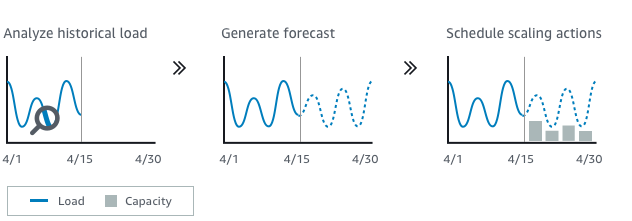How scaling plans work
AWS Auto Scaling lets you use scaling plans to configure a set of instructions for scaling your resources. If you work with AWS CloudFormation or add tags to scalable resources, you can set up scaling plans for different sets of resources, per application. The AWS Auto Scaling console provides recommendations for scaling strategies customized to each resource. After you create your scaling plan, it combines dynamic scaling and predictive scaling methods together to support your scaling strategy.
What is a scaling strategy?
The scaling strategy tells AWS Auto Scaling how to optimize the utilization of resources in your scaling plan. You can optimize for availability, for cost, or a balance of both. Alternatively, you can also create your own custom strategy, per the metrics and thresholds you define. You can set separate strategies for each resource or resource type.

What is dynamic scaling?
Dynamic scaling creates target tracking scaling policies for the resources in your scaling plan. These scaling policies adjust resource capacity in response to live changes in resource utilization. The intention is to provide enough capacity to maintain utilization at the target value specified by the scaling strategy. This is similar to the way that your thermostat maintains the temperature of your home. You choose the temperature and the thermostat does the rest.

For example, you can configure your scaling plan to keep the number of tasks that your Amazon Elastic Container Service (Amazon ECS) service runs at 75 percent of CPU. When the CPU utilization of your service exceeds 75 percent (meaning that more than 75 percent of the CPU that is reserved for the service is being used), then your scaling policy adds another task to your service to help out with the increased load.
What is predictive scaling?
Predictive scaling uses machine learning to analyze each resource's historical workload and regularly forecasts the future load. This is similar to how weather forecasts work. Using the forecast, predictive scaling generates scheduled scaling actions to make sure that the resource capacity is available before your application needs it. Like dynamic scaling, predictive scaling works to maintain utilization at the target value specified by the scaling strategy.
Important
If you use scaling plans only for predictive scaling, we strongly recommend that you set predictive scaling policies directly on your Auto Scaling resources instead. This option offers more features, such as using metrics aggregations to create new custom metrics or retain historical metric data across blue/green deployments. For more information about Amazon EC2 Auto Scaling, see Predictive scaling for Amazon EC2 Auto Scaling in the Amazon EC2 Auto Scaling User Guide. For more information about Application Auto Scaling, see Predictive scaling for Application Auto Scaling in the Application Auto Scaling User Guide.
For a guide for migrating from scaling plans to Amazon EC2 Auto Scaling predictive scaling policies, see Migrate your scaling plan.

For example, you can enable predictive scaling and configure your scaling strategy to keep the average CPU utilization of your Auto Scaling group at 50 percent. Your forecast calls for traffic spikes to occur every day at 8:00. Your scaling plan creates the future scheduled scaling actions to make sure that your Auto Scaling group is ready to handle that traffic ahead of time. This helps keep the application performance constant, with the aim of always having the capacity required to maintain resource utilization as close to 50 percent as possible at all times.
The following are the key concepts for understanding predictive scaling:
-
Load forecasting: AWS Auto Scaling analyzes up to 14 days of history for a specified load metric and forecasts the future demand for the next two days. This data is available in one-hour intervals and is updated daily.
-
Scheduled scaling actions: AWS Auto Scaling schedules the scaling actions that proactively increases and decreases capacity to match the load forecast. At the scheduled time, AWS Auto Scaling updates the minimum capacity with the value specified by the scheduled scaling action. The intention is to maintain resource utilization at the target value specified by the scaling strategy. If your application requires more capacity than is forecast, dynamic scaling is available to add additional capacity.
-
Maximum capacity behavior: Minimum and maximum capacity limits for auto scaling apply to each resource. However, you can control whether your application can increase capacity beyond the maximum capacity when the forecast capacity is higher than the maximum capacity.